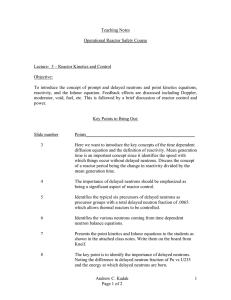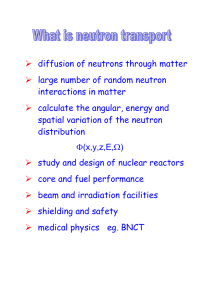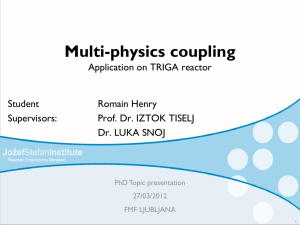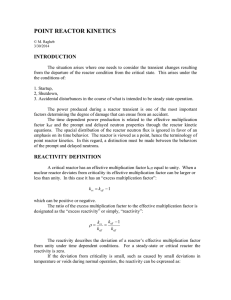Document 13443978
advertisement
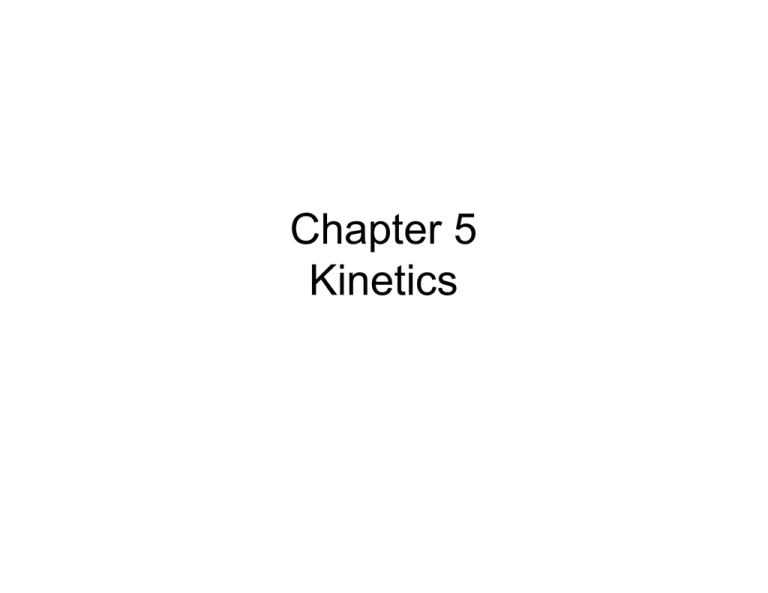
Chapter 5
Kinetics
Fission chain reaction
Public domain image from wikipedia.
Delayed neutrons
Delayed neutrons emitted from the decay of fission
prod
ducts
t long after
ft th
the fifissiion event.
t Dellay is caused
db
by
half-life of beta decay of delayed neutron pre-cursor
nucleus.
Delayed neutrons
Delayed neutrons are grouped into 6 groups of delayed
neutron precursors with an average decay constant Oi
defined for each.
each
Oi { The decay constant for the i th group of delayed neutrons
E i { The fraction of fission neutrons emitted by delayed
neutron precursor group i.
E { The fraction of fission neutrons that are delayed.
6
=
¦E
i=1
i
0075
E ~ 0.0075
Point Kinetic Equations
For an initially critical system
K
dp(t) ⎛ ρ (t) − β ⎞
=⎜
⎟ p (t ) + ∑ λk ck (t )
dt
⎝ Λ ⎠
k =1
dck (t)
t) βk
=
p(t) − λk ck (t)
dt
Λ
Most important assumption: Assumes that the perturbation introduced in
the reactor affects only the amplitude of the flux and not its shape.
Dynamic Reactivity ρ(t)
• Most important kinetics parameter
– Its variations are usually the source of
changes in neutronic power
– Only term that contains the neutron loss
operator (M operator)
• Associated to control mechanisms
• Also sensitive to temperature
– No units
• Expressed in terms of mk (milli-k) or pcm
Delayed-Neutron
Delayed
Neutron Fraction β(t)
• Effective delayyed neutron fraction is linked to the
constants of each fissionable isotope which
measure the fraction of fission product
precursors
– Called “effective” because it is weighted by the flux in
the reactor
• Can vary with burnup
– Different values exist at BOL and EOL
– Variations in burnup are on a much larger time scale
than usual range of application of point kinetics
equations
Prompt-Neutron
Prompt
Neutron Lifetime
Lifetime
• Measure of the average time a neutron
survives after it appears as either a prompt
neutron or a delayed-neutron
delayed neutron
Solution with one effective delayed
neutron precursor group
dP(t ) r0 − b
=
P (t ) + lC (t )
dt
Λ
dC(t ) b
= P(t ) − lC (t ), t ≥ 0
dt
Λ
Step reactivity change
t < 0 ⇒ r (t ) = 0, P (t) = P0
t ≥ 0 ⇒ r (t ) = r0
Solution
b
P(0) = P0 , C(0) = lΛ P0
Initial conditions
P(t ) = Pest , C (t ) = Cest
Solutions
r0 − b
sP =
l
C
P
+
Λ
b
sC = P − l C
Λ
Substitute
Solution
⎡ ⎛ ρ0 − β ⎞
⎤
⎢ s − ⎜ Λ ⎟ − λ ⎥ ⎡ P ⎤ ⎡0⎤
⎠
⎢ ⎝
⎥⎢ ⎥ = ⎢ ⎥
⎥ ⎣C ⎦ ⎣ 0 ⎦
⎢
β
s + λ⎥
−
⎢⎣
Λ
⎦
⎡ ⎛ ρ0 − β
⎢s − ⎜ Λ
⎣ ⎝
βλ
⎞⎤
=0
⎟⎥ [ s + λ ] −
Λ
⎠⎦
Λs 2 + (λΛ + β − ρ0 )s − ρ0λ = 0
Linear
Homogeneous
System
Non-trivial solution
if and only if
det A=0
Solution
1
s1,2 − − ( b − r0 + lΛ ) ±
2Λ
s1t
P (t ) = Pe
+ P2 e
1
s2t
−
b
r
+
l
+
4
l
r
Λ
Λ
(
)
0
0
2
s1t
and C (t ) = C1e + C2 e
s2t
Approximate solution
Assume
lΛ / b << 1
r0 << b
lr0
b − r0
s1 ≅
, s2 ≅ −
Λ
b − r0
b
r0
lr0
b − r0
P(t ) ≅ P0
exp
exp
t −
b
r
b
r
b
r
Λ
−
−
−
0
0
0
t
Solution
Solution
This solution is not valid for large changes in reactivity! ª§ E ·
§ OU 0 · § U 0 ·
§ U0 E
P(t ) # P0 Ǭ
¸ exp ¨
¸ exp ¨
¸t ¨
© /
© E U0 ¹ © E U0 ¹
¬© E U0 ¹
U0
0.0025, E
s11 ~ 25s
s ~ 0.2s
0 2s
1
2
0.0075, O
· º
¸ t»
¹ ¼
0.08s-1 , / 103 s
Prompt
p neutrons
Delayed neutrons
Reactor Period
• Defined as the power level divided byy the rate
change of power
p(t)
τ ((tt ) =
dp (t
)
dt
– Period of infinity implies steady-state
– Small positive period means a rapid increase in
p
power
– Small negative period means rapid decrease in power
– If period is constant, power varies according to
p(t) = p0 e t /τ
Reactor Period
• For the case with one delayed group
group, the
the
reactor period can be separated in two
parts
– Prompt period
–Stable
Stable period
• The solution has two exponential and they usualllly have very diff
differentt coeffi
fficiients.
t
Scenario 1
• ρ0 < 0
– Corresponds to a quick reactor shutdown
– Both roots are negative
– s2 <<< s1 thus the power drops almost
instantly to a fraction of its initial power
(prompt drop)
– However,
However it is impossible to stop a reactor
instantaneously
Example
• The second root is so
small that in the
matter of a fraction of
second becomes
inconsequential
• Power drops almost
instantly to the
coefficient of the first
exponential term
• Thus the stable
period is equal to 1/s1
• And the promp
pt
period is equal to 1/s2
1
0.9
0.8
0.7
0.6
0.5
0.4
0.3
0.2
0.1
0
0
0.1
0.2
0.3
0.4
0.5
0.6
0.7
⎡⎛ β ⎞
⎛ λρ 0 ⎞ ⎛ ρ 0 ⎞
⎛ ρ0 − β
P(t ) ≅ P0 ⎢⎜
xp
t
−
p
e
ex
⎟
⎜
⎟ ⎜
⎟
⎜
β
ρ
β
ρ
β
ρ
−
−
−
⎝ Λ
0
0
0
⎠
⎝
⎠
⎝
⎠
⎝
⎣
0.8
0.9
1
⎞ ⎤
⎟ t⎥
⎠ ⎦
Courtesy of canteach@candu.org. Used with permission.
Demo
• Negative Step insertion of -12mk
12mk
• Parameters
– Bet
B ta = 0
0.006
006
– LAMBDA = 0.001
– Lambda = 0.1 s-11
• P
Power d
drops by
b 33% almost
l
t instantly,
i t tl and
d
then decays slowly
Scenario 2
• 0 < ρ0 < β
• One root is positive and the other is
negative
• Power increases rapidly and the grows
exponentitialllly
• Power increases
rapidly by beta/(beta
rho)
– Positive prompt jump
• Stable period is equal
equal
to 1/s1
• Prompt period is equal
to 1/s2
1.4
1.2
1
0.8
0.6
0.4
0.2
0
0
0.1
0.2
0.3
0.4
0.5
0.6
0.7
0.8
0.9
1
Demo
• Positive Step insertion of 1mk
• Parameters
–B
Betta = 0.006
0 006
– LAMBDA = 0.001
–Lambda = 0.1 s-11
• If rho approaches beta, the stable period
becomes very short
Scenario 3
• ρ0
super critical)
0 > β (prompt super-critical)
• Reactor is critical without the need of the
delayed neutrons
• One root is positive and one is negative
• Reactor period becomes less than 1s
• Power increases at a
a
very rapid rate
• Disastrous
consequences
– Unless a feedback
mechanism can cancel
out the reactivity
8
7
6
5
4
3
2
1
0
0
0.01
0.02
0.03
0.04
0.05
0.06
0.07
0.08
0.09
0.1
Demo
• Positive Step insertion of 7mk
• Parameters
–B
Betta = 0.006
0 006
– LAMBDA = 0.001
–Lambda = 0.1 s-11
• Reactor is critical (or supercritical) without
the presence of delayed neutrons
– Prompt jump dominates
Limiting cases- Small reactivity insertions
r0 = b , thus
T=
s1 = l1 < l2 ... < l −1
6
l
bi l
1
1
=
≅
l + ∑ ≅
s1 r0 i=1 li r0 k −1
r0 ? b , thus s1 ? li
Limiting cases- Large reactivity insertions
ρ0
s1
s1 + β l −1
l −1 6
≅
+
β =
−1 ∑ i
−1
s1 + l
s1 + l i=1
s1 + l −1
T=
1
l
l
≅
≅
s1 k( ρ0 − β ) k −1
Positive Reactivity
Negative Reactivity
Typical parameters
LWR
CANDU
Fast Reactor
Λ
5 x 10-55
1 x 10-33
1 x 10-66
β
0.0075
0.006
0.0035
λ
0.1
0.1
0.1
MIT OpenCourseWare
http://ocw.mit.edu
22.05 Neutron Science and Reactor Physics
Fall 2009
For information about citing these materials or our Terms of Use, visit: http://ocw.mit.edu/terms.
